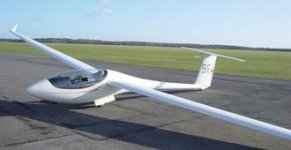PlaneSpottingWorld welcomes all new members! Please gives your ideas at the Terminal.
Schleicher ASW 24
| ASW 24 sailplane, competition number '96' owned by Imperial College Gliding Club | |
| Type designation | ASW 24 |
| Competition class | Standard |
| Number built | 249 |
| Crew | 1 |
| Length | 6.55 m |
| Height | 1.3 m |
| Cockpit width | 0.64 m |
| Cockpit height | 0.81 m |
| Wingspan | 15 m |
| Wing area | 10.00 m² |
| Aspect ratio | 22.5 |
| Wing profile | DU 84-158 |
| Empty mass | ca. 230 kg |
| Water ballast | 155 kg (ASW 24) 160 kg (ASW 24B) |
| Tail water ballast | unavailable |
| Maximum mass | 500 kg |
| Wing loading | ca. 31.0 - 50.0 kg/m² |
| Minimum sink rate | ca. 0.55 m/s at 31 kg/m² |
| Best glide ratio | ca. 43 (ASW 24) ca. 44 (ASW 24B) |
The ASW 24 is a modern single seat high performance composite Standard Class sailplane.
History
The ASW 24 was designed by Schleicher's Gerhard Waibel, with Delft University professor Loek Boermans undertaking the role of aerodynamicist. The prototype made its first flight in 1987, having entered serial production later the same year. It nominally remained in production until 2000, although only a score were built in the mid-to-late nineties.
It entailed a large development effort, as it was a complete departure from the preceding ASW 19 and pioneered several successful innovations. The fuselage, airfoils, wings and empennage were completely new, as well as many systems, e.g. the electrical ballast management. The structure employed a large amount of the then still exotic carbon fibre. The OSTIV Award-winning safety cockpit made use of an organic shape, tall sidewalls, crumple zones and exotic aramid fibres for crash protection. A large wheel with a disc brake and a large canopy with excellent visibility were other strong points of the type.
The ASW 24 was moderately successful in competitions. It won a single World Championship in 2001, fourteen years after its market launch. As the contemporary LS7, the ASW 24 overstretched the technology available at the time: it has excellent performance in the cruise but less so in the slow flight range. The higher-than-usual thermalling speed revealed itself a disadvantage in the typical competition gaggles, and its performance degrades somewhat when subject to turbulence, rain or wing contamination. However, the addition of winglets and a change to the outer wing leading edge, making it slightly blunter, improved these characteristics significantly.
According to World Champion Sarah Steinberg, it needs to be always proactively flown in thermals, thus imposing a higher workload upon the pilot. Notwithstanding, the aesthetically pleasing ASW 24 is a comfortable, safe and pleasant sailplane with high cross-country performance that remains competitive up to national championship level in most countries.
The fuselage of the ASW 24 was the basis, with small modifications, for the subsequent ASW 27, ASW 28 and ASG 29. It was superseded in production by the ASW 28.
Variants
- The ASW 24B of 1993 introduced winglets and a slightly revised airfoil that were partially successful in addressing the handling and performance issues.
- The ASW 24E is a nominally self-launching variant employing a Rotax 275 engine and a propeller mounted on a retractable pylon. The engine installation is peculiar for its small size and power, more typical of a turbo, and for its manual start with a pilot-operated ripcord.
| Number built | 54 |
| Empty mass | ca. 275 kg |
| Engine type | Rotax 275 1 cylinder 2-stroke |
| Engine power | |
| Fuel tank capacity | |
| Climb rate in powered flight | |
| Range in 'saw-tooth' operation |
Sources
- Alexander Schleicher website
- Johnson R, An FTE of the Schleicher ASW-24, Soaring, May 1994
- Thomas F, Fundamentals of Sailplane Design, College Park Press, 1999
- Simons M, Segelflugzeuge 1965-2000, Eqip, 2004
- Sailplane Directory

